|
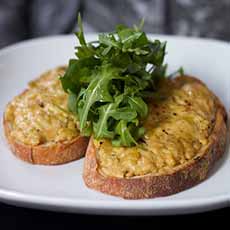
[1] A modern execution of the Welsh Rarebit, topped sauce instead of a pourover (photo by Tristan Kenney is licensed under-CC-BY-2.0).

[2] This upscale version uses an artisan bread loaf with the crusts cut off (photo by The Food Place.co_.uk is licensed under CC-BY-2.0).
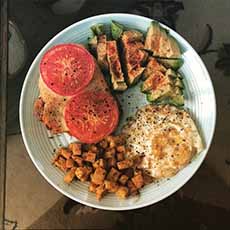
[3] This creation has a side of tomatoes, a fried egg and sliced avocado. Do we spy cubes of ham? That’s not a Welsh Rarebit; it’s a Welsh Meatbit—for the bit o’ meat (photo by by Tim Brauhn is licensed under CC-BY-2.0).
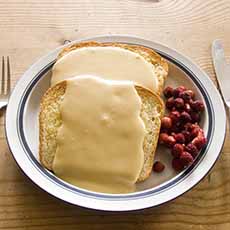
[4] This version couldn’t be simpler, with a side of berries (photo by by Pod Chef is licensed under CC-BY-2.0).
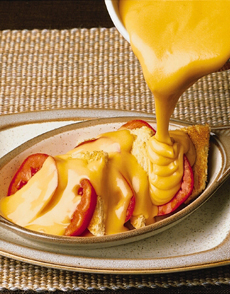
[5] A tasty execution of toast, tomatoes and lots of sauce (photo © Wisconsin Milk Marketing Board).
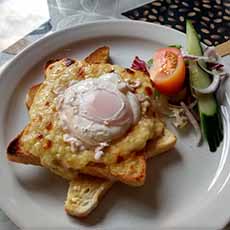
[6] A Buck Rarebit, topped with an egg (photo by Tubblesnap is licensed under CC-BY-2.0).
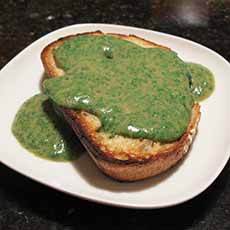
[7] An “Irish Rarebit” turns the cheese sauce green with lots of herbs (photo by Brian Fling is licensed under CC-BY-2.0).

[8] How classy has Rarebit become from its peasant origins? It’s sold in jars at tony Fortnum & Mason (photo by Viv Lynch is licensed under CC-BY-2.0).
|
|
September 3rd is National Welsh Rarebit Day, but it’s a misnomer, as you’ll see in the next section.
THE HISTORY OF WELSH RAREBIT
The simple dish of melted cheese over toasted bread—and possibly some beer or ale—was originally called Welsh Rabbit.
It was so named because it was a meal for poor families who had no meat.
It was a dinner substitute when the man of the family had been unsuccessful in hunting down a rabbit.
In town, there was no hunting and meat came from the butcher. Poor people could not afford a rabbit, or even a chicken—much less beef or pork.
Perhaps ironically, perhaps hopefully, it the dish was called a rabbit. Certainly, no one would refer to a mean meal of toasted stale bread topped with a sauce of melted cheddar bits as a “rare” bit.
The earliest known use of the term “Welsh Rabbit” was in 1725.
The misnomer, rarebit, is first noted 60 years later, in 1785.
Why a misnomer? The word “rarebit” has no meaning beyond referring to this dish.
Was “Rarebit” made up on purpose, was it a typo, or did someone simply mis-year “rabbit?”
We don’t know.
So “rarebit” it remained. It’s now a traditional British dish, available everywhere from pubs and finer restaurants alike (photo #2)—with a pint of beer or ale, of course.
The modern cheese sauce is more tasty than the original, flavored with not only beer or ale, but with Worcestershire sauce, cayenne, mustard and paprika—ingredients unknown to a poor family (and Worcestershire sauce not invented until 1837).
Sometimes an egg is served atop the Rarebit, and then it’s called a Buck Rarebit (although a “cluck” rarebit sounds more logical to us).
RECIPE: WELSH RAREBIT
You can use this cheese sauce on anything, from mac and cheese and Eggs Benedict to cheeseburgers and vegetables (how about a loaded baked potato?).
Don’t just cut the cheddar into large hunks, place it in the microwave and hope for the best. Shred, grate, or chop the cheese finely. Place your ingredients into a heavy-bottomed saucepan, then use a low heat to melt the cheeses. It is very helpful here to stir constantly, especially with a whisk.
Keep stirring and don’t allow the melting cheese to settle in any area on the bottom of the pan—it could scorch.
Welsh rabbit is similar to fondue, except that the melted cheese is poured over toast instead of dipping bread chunks into a pot of melted cheese.
Ingredients For 2 Servings (2 Slices Each)
2 tablespoons butter
2 tablespoons all-purpose flour
1/3 cup milk
1/2 cup beer or ale
1 teaspoon dry mustard
1/4 teaspoon each cayenne pepper and paprika
1 teaspoon Worcestershire sauce
1-1/2 cups sharp Cheddar, shredded
1 egg yolk
4 slices bread for toast
Optional: sliced tomato
Optional garnishes: fresh snipped chives, parsley or thyme
Variations
Cheddar was most common in poor households, but you can afford any cheese you like. In fact, you can:
Vary The Cheese: You can use any semi-hard cheese, or a blend of cheeses. Like fondue, Welsh rabbit is a great way to use up scraps of cheese. If it’s a blend, you can even add softer cheese.
Vary The Alcohol: Instead of beer or ale, use white wine. You can also add Kirschwasser* along with the wine, as is done with fondue.
Add Herbs To The Sauce. Any herb or combination of herbs will enhance the sauce. If you like heat, add chiles, too; or more cayenne.
Make A Playful Sauce. Add sliced olives or sweet gherkins, diced pimento or artichoke hearts—whatever.
Vary The Bread: You can (and should!) use artisan bread. We like a rustic country loaf; although semolina and raisin or raisin-nut bread elevate the dish, indeed. Perhaps an English muffin?
Add Vegetables. Top the bread with tomatoes, broccoli florets, kale, sliced baby potatoes, whatever you like. Then pour the sauce over them.
Add Bitter Greens: Arugula or watercress in a Dijon vinaigrette is an excellent counterpoint to the richness of the cheese.
Add A Side Salad: A salad dressed in vinaigrette .
Add An Egg: Atop the cheese, a fried egg turns the Welsh Rarebit into a Buck Rarebit.
Add Fruit: A side of sliced apples or grapes is a different variation of “cheese and fruit.”
Serve With Toasted Baguette & Crudités: Instead of pouring over toast, use the cheese sauce to dip small toasts and raw vegetables.
Preparation
1. PREPARE THE TOAST. If you’re not using artisan bread, try rye toast or whole grain toast because of the added flavor; but use whatever bread you have.
2. MAKE THE ROUX. Melt the butter in a saucepan over low heat; whisk in the flour until smooth and simmer the roux for two minutes.
3. ADD THE LIQUIDS. Whisk in the milk, then the beer. You can use leftover beer: The effervescence cooks out. The more flavorful the beer, the better the dish.
4. ADD THE SEASONINGS. Add cayenne, mustard and paprika one at a time, whisking until smooth. Add the Worcestershire sauce and whisk to combine.
5. ADD THE CHEESE. Whisk in the cheddar, 20% at a time, and blend until smooth.
6. ADD THE YOLK. Remove the pan from the flame; whisk in the egg yolk for extra richness and body.
7. PLATE. Place two pieces of toast on each plate. Top with tomato slices. Pour the cheese sauce over toast. Garnish with herbs.
Who needs a real rabbit: This “poor man’s supper” is delicious!
> Find More Types Of Cheese In Our Cheese Glossary
> Discover The History Of Cheese
|







